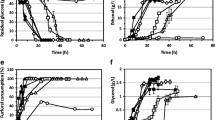Summary
A wild-type strain of Cryptococcus neoformans and Pseudomonas aeruginosa were used to convert n-pentadecane to the corresponding dioic acid, tridecane 1,13-dicarboxylic acid (DC-15). Altering the cell permeability by treating C. neoformans with 1% (v/v) toluene or 7% (v/v) Triton X-100 stimulated production of DC-15 by 1.5-fold and fourfold, respectively. Furthermore, DC-15 productivity was increased from 2.5 mg/l per hour to 18 or 30 mg/l per hour, respectively. If 10% (v/v) hexane was used to treat the yeast culture, stimulation of DC-15 production could reach 200% and more viable cells remained compared to the toluene-treated culture. Data from the organic solvent treatment experiment indicated that the solvent with a higher polarity showed a more adverse effect on DC-15 production. P. aeruginosa was vulnerable to most organic solvents; however, Tween 80 could greatly stimulate the conversion of n-pentadecane to DC-15. Although organic solvents and non-ionic detergents could enhance DC-15 formation by microbial conversion, it was inhibited by elevated levels of DC-15.
Similar content being viewed by others
References
Chiao JS, Shen YQ, Lou CJ, Xia J, Xia GX (1981) Regulatory effect of urea on the diterminal repression. Acta Phytophysiol Sinica 7:175–183.
Bang WG, Lang S, Sahm H, Wagner F (1983) Production of l-tryptophan by Escherichia coli cells. Biotechnol Bioeng 25:999–1011.
Bao HZ, Jiao RS (1984) Involvement of cytochrome P450 and urea in the alkane metabolism by Candida tropicalis. Acta Mycol Sinica 3:45–53.
Demain AL, Birnbaum J (1968) Alteration of permeability for the release of metabolites from the microbial cells. Curr Top Microbiol Immunol 46:1–25.
Good RC, Gunsalus IC (1960) Amino acid synthesis. US patent no. 2,927,059.
Harrop AJ, Hocknull MD, Lilly MD (1989) Biotransformations in organic solvents: a difference between Gram-positive and Gram-negative bacteria. Biotechnol Lett 11:807–810.
Hartley JC, Vedamuthu ER (1975) β-Galactosidase of Propionibacterium shermanii. Appl Microbiol 29:74–80.
Inoue A, Horikoshi K (1989) A Pseudomonas thrives in high concentrations of toluene. Nature 338:264–266.
Kester AS, Foster AW (1963) Diterminal oxidation of long-chain alkanes by bacteria. J Bacteriol 85:859–867.
Liu CM, Johnon M (1971) Alkane oxidation by a particulate preparation from Candida. J Bacteriol 106:830–834.
Morinaga T (1982) Microbial production of saturated dicarboxylic acid. Japanese Patent no. (A) 57–65 194.
Playne MJ, Smith BR (1983) Toxicity of organic extraction reagents to anaerobic bacteria. Biotechnol Bioeng 25:1251–1265.
Shen YQ, Lou CJ, Xu KR, Xia JJ, Jiao RS (1979) Studies on microbial production of long-chain dicarboxylic acids from n-alkanes (III): some factors affecting the high yield of tridecane-1,13-dicarboxyli c acids with a polyploid mutant of Candida tropicalis. Acta Phytophysiol Sinica 5:385–393.
Shiio I, Uchio R (1971) Microbial production of long-chain dicarboxylic acids. Agric Biol Chem 35:2033–2042.
Uchio R, Shiio I (1972) Microbial production of long-chain dicarboxylic acids from n-alkanes (II): production by Candida cloacae mutant unable to assimilate dicarboxylic acid. Agric Biol Chem 36:426–433.
Author information
Authors and Affiliations
Additional information
Offprint requests to: E.-C. Chan
Rights and permissions
About this article
Cite this article
Chan, EC., Kuo, J., Lin, HP. et al. Stimulation of n-alkane conversion to dicarboxylic acid by organic-solvent- and detergent-treated microbes. Appl Microbiol Biotechnol 34, 772–777 (1991). https://doi.org/10.1007/BF00169348
Received:
Accepted:
Issue Date:
DOI: https://doi.org/10.1007/BF00169348




